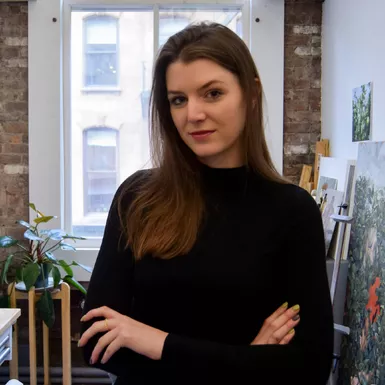
Heather V McLeod is an artist exploring identity and the psychology by which we perceive others. Interested primarily in portraiture and representative work, Heather creates pieces with the intent of capturing the character of the figure portrayed. She plays with the use of symbolism and concealment to enhance the narrative and evoke a quiet yet humorous side to portraiture.
Born and raised in the greater New York area, Heather received her MFA from The New York Academy of Art in 2021 and her BFA from Rhode Island School of Design in 2016. In 2017 she was awarded a Fulbright Study/Research Award in Perugia, Italy where she lived and worked for a year. She is a recent recipient of two Elizabeth Greenshields Foundation Grants and The Leslie T. and Francis Posey Scholarship. She has been featured in a number of exhibitions in the U.S. and abroad and has been the recipient of a number of art related awards, including most recently AXA Art Prize Finalist.
There exists a space between our outward appearance and inner self. It is a space lined with objects that carry a record of our experiences and a glimpse into our past. My work explores this space.
Through non-traditional portraiture, I draw a line between physical appearance and identity. I use objects related to a person to develop their distinct iconography. These objects act to enhance the narrative of the figure we cannot see and welcome a range of interpretations. My art focuses on the gesture of the hand, on the vulnerable spot behind the ear and the less observed features that stand in for the whole.
I have always felt a need to hide a part of myself in any situation. Many of us have this tendency, whether consciously or unconsciously, and I enjoy navigating this territory. My work speaks to the individual struggles of fragility, femininity, and concealment while allowing the subject to remain hidden behind a light veil of humor. A figurine threatening to topple off of a chair speaks to the fragility of the feminine form. A bouquet of flowers past their prime contemplates a reflection of former youth. By concealing the face, one must find meaning in the symbolism of what we are permitted to see.
The elusiveness that results parallels the elusive nature of our own identity and, ultimately, reality.